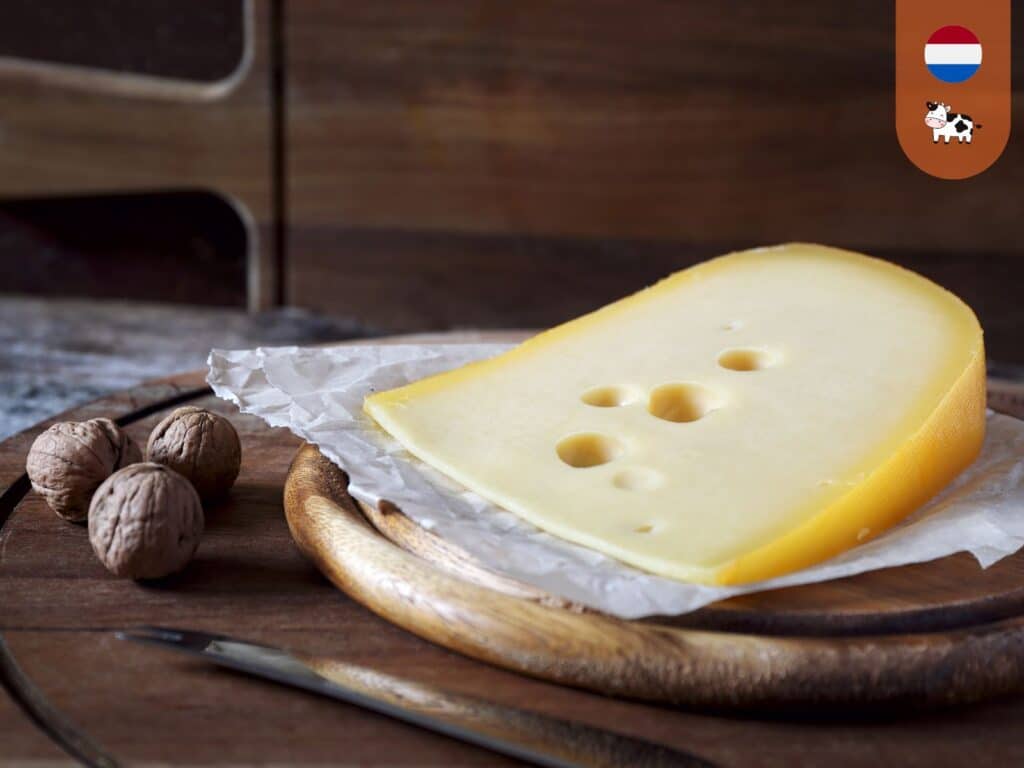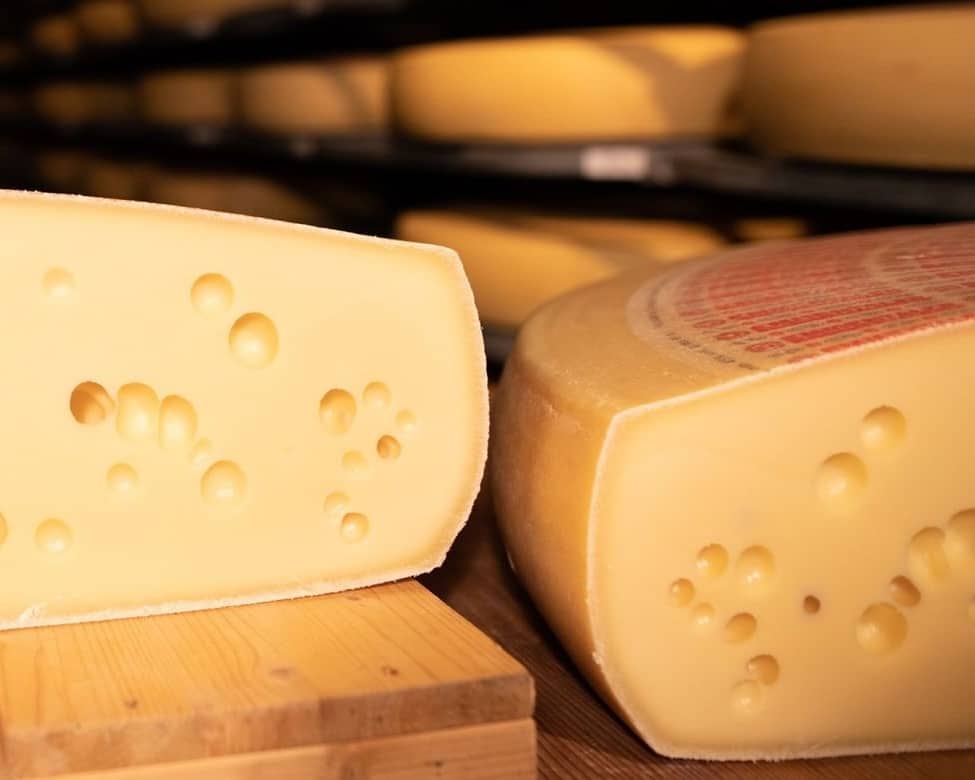Maasdam cheese, often celebrated for its unique flavour and eye-catching appearance, is a true gem in the world of dairy products. Originating from the Netherlands, this semi-hard cheese has captured the hearts of cheese lovers around the globe. In this blog post, we’ll delve into the history, characteristics and the crafting process of Maasdam cheese.

A Brief History of Maasdam Cheese
Maasdam cheese has its roots in the Netherlands, specifically the region near the town of Maasdam, which lends the cheese its name. The cheese was first developed in the 1980s by Dutch cheesemakers who sought to create a domestic alternative to Swiss Emmental cheese. Inspired by traditional Swiss cheesemaking techniques, they aimed to produce a cheese with a similar flavour profile and texture but with a distinct Dutch twist.
The result was a cheese that not only features the characteristic holes (or “eyes”) found in Swiss cheese but also boasts a slightly sweeter and nuttier flavour. Maasdam has since gained popularity both locally and internationally, becoming a staple in cheese platters, sandwiches, and a variety of dishes.
Characteristics of Maasdam Cheese
Appearance
One of the most striking features of Maasdam cheese is its appearance. The cheese has a smooth, pale yellow rind that encases a pale, creamy interior.
Its most distinguishing characteristic is the large, irregular holes that pepper its surface, a result of the fermentation process. These holes not only enhance the visual appeal but also contribute to the cheese’s texture and flavour.
Flavour Profile
Maasdam cheese is known for its mild, nutty flavour with a slightly sweet finish. This flavour is a result of the specific bacterial cultures used during fermentation and the cheese’s ageing process.
Typically, Maasdam is aged for about four to twelve months, with the flavour intensifying as it matures. While young Maasdam is creamier and milder, aged varieties develop deeper, more complex flavours. As a result, this is a versatile cheese suitable for various culinary applications.
Texture
The texture of Maasdam cheese is semi-hard, making it easy to slice or grate. It is smooth and creamy, with a slight elasticity that provides a delightful mouthfeel. Moreover, the presence of holes adds a unique textural element that sets it apart from other cheeses, making each bite an enjoyable experience.
The Crafting Process of Maasdam Cheese
The process of making Maasdam cheese is a labour of love that combines traditional techniques with modern technology. Here’s a brief overview of the steps involved:
1. Milk Selection
The journey begins with high-quality cow’s milk, sourced from local dairy farms. The milk must be fresh and rich in flavour to ensure the best possible end product.
2. Pasteurisation
The milk is then pasteurised to eliminate harmful bacteria while preserving its natural flavours. This step is crucial in maintaining the quality and safety of the cheese.
3. Curd Formation
After pasteurisation, cultures and rennet are added to the milk, initiating the curdling process. The milk thickens as the curds form, separating from the whey. This is where the unique bacterial cultures come into play, contributing to the cheese’s flavour and texture.
4. Cutting and Cooking
Once the curds have formed, they are cut into small pieces and gently cooked. This step helps release more whey and influences the cheese’s texture. The curds are then stirred and heated further, promoting the development of the cheese’s characteristic holes.
5. Moulding and Pressing
The curds are placed into moulds and pressed to remove excess whey. This stage shapes the cheese and helps achieve its desired density. After pressing, the cheese is removed from the moulds and placed in a brine solution for salting.
6. Ageing
Finally, the cheese ages in climate-controlled facilities. During this maturation process, the flavours develop and mature, resulting in the delightful cheese we know as Maasdam. The ageing period can vary, but typically ranges from four to twelve months.
Culinary Uses of Maasdam Cheese
Maasdam cheese is incredibly versatile and can be enjoyed in numerous ways:
Cheese Boards
Maasdam’s mild flavour and attractive appearance make it a perfect addition to cheese boards. Pair it with fruits, nuts, and a selection of cured meats for a delightful appetiser.
Sandwiches and Paninis
Whether in a classic ham and cheese sandwich or a gourmet panini, Maasdam adds a creamy, nutty flavour that elevates any meal. Its melting properties also make it an excellent choice for grilled cheese.
Salads
Shredded or cubed Maasdam cheese can add a flavourful twist to salads. Try it in a mixed green salad with nuts and dried fruits for a satisfying crunch and taste.
Cooking and Baking
Maasdam’s melting characteristics make it ideal for cooking. Use it in sauces, pasta dishes, or baked recipes for a rich and creamy texture. It’s also a delightful topping for pizzas.
Pairing Suggestions
When it comes to pairing Maasdam cheese, the options are endless. Here are a few suggestions:
- Wines: Try pairing Maasdam with a light, fruity white wine like Riesling or a crisp Chardonnay. For red wine lovers, a medium-bodied Pinot Noir complements the cheese’s nuttiness beautifully.
- Other Beverages: If you prefer non-alcoholic options, a refreshing apple cider or a light herbal tea can enhance the cheese’s flavours.
- Condiments: Sweet chutneys or honey drizzled over Maasdam cheese can enhance its natural sweetness, creating a perfect balance.
Conclusion
Maasdam cheese is more than just a delicious dairy product; it’s a testament to the art of cheesemaking and a celebration of Dutch culinary tradition. With its unique flavour, appealing texture, and versatility in the kitchen, it’s no wonder this cheese has earned a place on tables around the world.
Whether you’re a seasoned cheese connoisseur or a casual fan, Maasdam cheese is definitely worth exploring. So, next time you’re at the cheese counter, don’t forget to give this delightful cheese a try—you won’t be disappointed!
